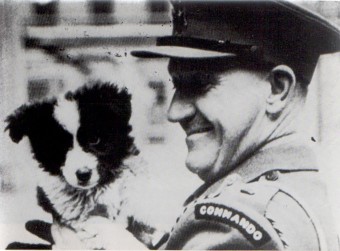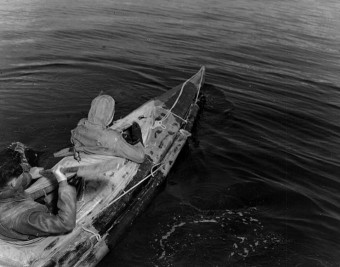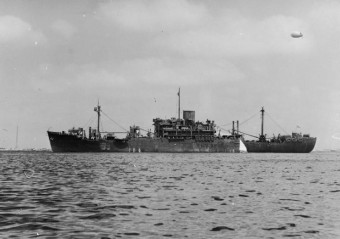Roger Courtney and a Watery Gamble- The Establishing of the SBS
 Described by the BBC as the “Shadowy sister of the SAS”, The Special Boat Service (more commonly known as the SBS) is likely one of the most well-trained and elite special forces units around today that few in the world have ever heard of, despite performing countless harrowing missions, dozens of hostage rescues and more than its fair share of daring night time raids going all the way back to WWII when an officer by the name of Roger “Jumbo” Courtney risked a court-martial to demonstrate to his superiors just how valuable a unit like the SBS could be.
Described by the BBC as the “Shadowy sister of the SAS”, The Special Boat Service (more commonly known as the SBS) is likely one of the most well-trained and elite special forces units around today that few in the world have ever heard of, despite performing countless harrowing missions, dozens of hostage rescues and more than its fair share of daring night time raids going all the way back to WWII when an officer by the name of Roger “Jumbo” Courtney risked a court-martial to demonstrate to his superiors just how valuable a unit like the SBS could be.
Little is documented about Courtney’s life prior to his military service in WWII other than that he was an avid big game hunter and adventurer in Africa for a number of years. This is particularly important to the story at hand as he often regaled his fellow soldiers with stories about hunting lions and other big game in a canoe.
When Courtney heard about the outbreak of WWII, he returned to Scotland and enlisted in the military; sometime in 1940, he began serving with the now defunct No 8 Guards unit. Almost as soon as he became a commando with the No 8’s, Courtney managed to score a meeting with the Admiral of the Fleet, Roger Keyes. In the meeting, Courtney tried to sell the sceptical Admiral on the benefit of using canoes to quite literally “hunt Germans”. He argued that small, collapsible canoes could be used to silently sneak where powered boats could not. Keyes summarily dismissed Courtney’s proposal, stating that canoes were better suited for the boy scouts than the army.
Undeterred by Admiral Keyes’ lack of vision, Courtney arranged for a meeting with another high-ranking military official, Admiral Theodore Hallett, in the hopes that he would see the benefit of the proposal. Like Keyes, Hallett dismissed Courtney’s idea outright.
Frustrated with how quick his superiors had been to dismiss his proposal, Courtney, later described by Major David Sutherland as “a hard-drinking white hunter with a big line of bullshit and a persuasive tongue”, came to the conclusion that the only way to prove that his idea could work was to put it into practise.
Four days after his failed meeting with Admiral Hallett, Courtney silently paddled a canoe along the River Clyde and stealthily climbed aboard the HMS Glengyle.
Once aboard, Courtney sneaked his way to the Captain’s quarters and scribbled his initials on the door. Just for good measure, before leaving he stole one of the ship’s deck gun covers, which had the ship’s name on it.
Courtney then slyly slipped away undetected and made a beeline for the nearby Argyll Arms Hotel where he knew Admiral Hallett was currently meeting some military bigwigs. Once there, Courtney waltzed up to Hallett’s private room, reportedly dressed only in a pair of swimming trunks, barged in and proudly proclaimed that he’d just managed to sneak aboard the Glengyle and make it to the captain’s quarters unmolested. When the captain of the Glengyle, who just so happened to be present at the meeting, scoffed that his ship could be infiltrated in such a way, Courtney unrolled the deck gun cover and placed it on the table.
Although Courtney had committed a potentially court-martial-able offence, as well as risked getting himself mistaken for an enemy and shot during the infiltration of the Glengyle, the fact that he’d been able to do this and make it to the captain’s quarters without being spotted during war time while half naked to boot, so impressed his superiors that they reconsidered their stance on how effective soldiers with foldable canoes could be.
 After his stunt, Courtney was asked to provide another demonstration, this time sanctioned, infiltrating a submarine depot ship. When that was successful as well, he was promoted and given command of 12 men, who he then trained in clandestine operations and the use of the “fol-boat”, a collapsible canoe made of rubber and wood that could be assembled or broken down rapidly.
After his stunt, Courtney was asked to provide another demonstration, this time sanctioned, infiltrating a submarine depot ship. When that was successful as well, he was promoted and given command of 12 men, who he then trained in clandestine operations and the use of the “fol-boat”, a collapsible canoe made of rubber and wood that could be assembled or broken down rapidly.
The “fol-boat brigade”, as it was then known, carried out numerous missions during WWII, most notably paddling into an enemy port near the mouth of the Gironde and destroying several key ships harboured there in an operation that Winston Churchill claimed accelerated the end of the war by “six months”.
As for Courtney, despite being highly involved in the gruelling training of the first waves of SBS commandos, he wasn’t with the force very long, having to return to the U.K. due to health issues. He was ultimately relegated to a desk job and died just a few years after the war ended.
Today his legacy lives on in the form of one of the most highly trained and terrifyingly effective units of soldiers on Earth.
If you liked this article, you might also enjoy our new popular podcast, The BrainFood Show (iTunes, Spotify, Google Play Music, Feed), as well as:
- Why Port and Starboard Indicate the Left and Right Side of a Ship
- From 1860-1916 the Uniform Regulations for the British Army Required Every Soldier to have a Moustache
- The Man Who Fought in WWII With a Sword and Bow
- How Were Kamikaze Pilots Chosen?
- Why People on Planes and Ships Use the Word “Mayday” When in Extreme Distress
Bonus Facts:
- According to one time senior member of the British Secret Intelligence Service (MI6), Walter Kirke, in a diary entry of his dated June of 1915, MI6 at one point used human semen as invisible ink. This was revealed in Dr. Keith Jeffery’s book, “MI6: The History of the Secret Intelligence Service 1909-1949.” Further, according to a letter by another MI6 officer, Frank Stagg, the head of MI6 at the time, Captain Sir Mansfield Cumming (I can’t make this stuff up), even coined the slogan “every man his own stylo,” when the discovery was made that semen made an excellent invisible ink impervious to most common detection methods. The only downside to this invisible ink was that, if it wasn’t used fresh, it tended to smell rancid. This became a problem when one Major Richard Holme decided to stock up on his ink supply, storing it in a bottle for later use. According to Stagg, “His letters stank to high heaven and we had to tell him that a fresh operation was necessary for each letter.”
- Along with supposedly using canoes to silently hunt lions in the African savannah, Roger Courtney also claimed to have single-handedly paddled 3,500 miles on his own down the River Nile.
- To join either the SAS or SBS you have to pass an infamously brutal and unforgiving selection process which involves a month of gruelling physical exercise culminating in a 40 km march across the harshest terrain Britain has to offer. Nine weeks of training in the jungle. Fourteen weeks of training in demolitions, reconnaissance and a variety of other advanced combat tactics. The process then culminates in something known as “Survive, Evade, Resist, Extract” training which involves releasing the recruits into the woods where they are hunted down by Royal Marines who will then interrogate them for several weeks using sleep, food, water and sensory deprivation. If a recruit fails during any one of these or gives any answer other than their name, rank, date of birth or army number, during the interrogation process, they will fail. Additionally, recruits hoping to join the SBS are required to undertake several more months of water-based training which involves learning how to do such amazing things as infiltrate and exit submarines while they are submerged, and diving out of planes into freezing cold water in near zero visibility. Unsurprisingly, over 90% of recruits who apply for the SBS or SAS fail.
- Recruits hoping to join the SBS or SAS can only apply a maximum of two times before they’re barred from ever trying again.
- The official motto of the SBS is “By Strength and Guile” which contrasts quite starkly with the motto of their sister unit which is simply, “Who dares wins”.
- The SBS and SAS work in alternative six month long shifts, during which they will train constantly to keep their skills as sharp as possible. These training sessions are understandably rather secretive, but are known to involve live fire trainings exercises and mock raids on potential terrorist targets to test their security. In one such mock raid, members of the SBS broke into a nuclear power plant in Scotland in less than a minute, exposing various issues with security at that plant.
- In regards to live fire training exercises, both the SBS and SAS are said to always train using live ammo and often use real people as hostages. The SAS in particular is known to invite foreign dignitaries to take part in these exercises to demonstrate their skill and composure.
- For anyone wondering about the difference between the two units, while both the SAS and SBS are fairly analogous in terms of their reputation, skill and basic training, as their names would suggest, the Special Air Service specialise in aerial combat and parachuting, whereas the Special Boat Service has an affinity for water-based and amphibious combat. That said, the SBS has been known to take part in land-based missions when the need arises and vice versa. Both units also set aside a small, constantly rotating contingent of men for counter-terrorism duties who are on call 24 hours a day, 365 days a year. Despite their close proximity to one another, the relationship between the SBS and SAS is a notably chilly one with both units displaying various levels of animosity towards one another.
- SAS : Great Britain’s Elite Special Air Service
- Special Boat Service: A force never far from the front line of controversy
- British hostage murder: SBS moved quickly but hostages were shot before they entered compound
- Shake-up in Special Boat Service over claims it ‘panicked and fled’ in Iraq
- End your rift, SAS and SBS are told
- International Counter-Terrorism: British Special Air Service (SAS)
- The SAS vs The SBS
- SBS Skills & Techniques
- Daring Missions of World War II
- Shadowy sister of the SAS
- Meet the SBS
- Special Forces: Roll of Honour
- The Story of Britain’s Undercover Forces
- SBS in WWII
- Secret Forces of WWII
- Special Boat Services
| Share the Knowledge! |
|






Interesting article. Brave men back in those days .